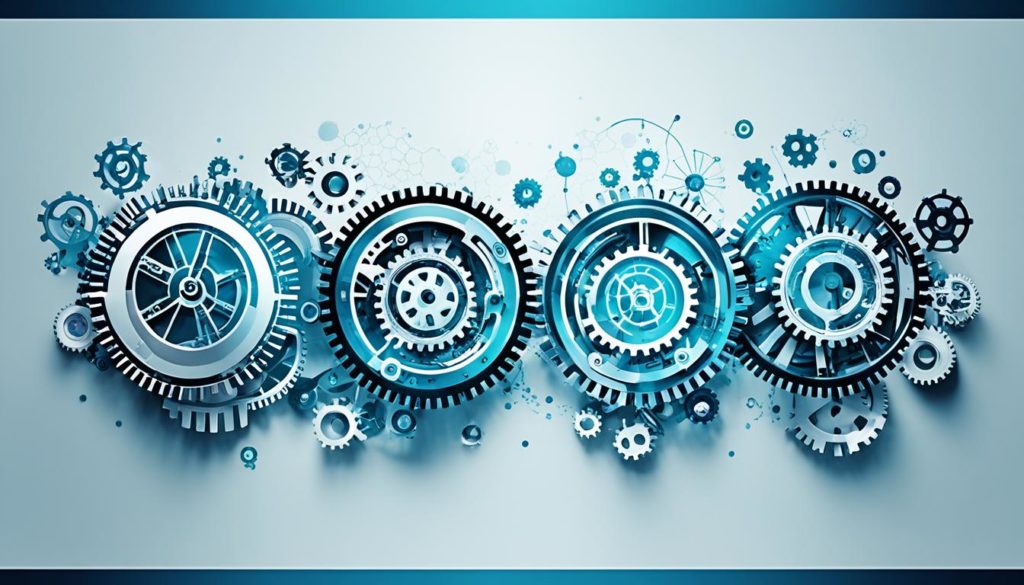
Did you know that using AI to automate simple tasks can really boost productivity? In today’s world, dealing with distractions is key to staying productive. The idea of “work smarter, not harder” is more than just a saying. It’s a path to success and better health.
Getting past fears and distractions can make a big difference. Having an organized workspace and focusing on one task at a time helps a lot. Using the latest tech can also make our work flow better.
Mental blocks can be tough, but we can overcome them. With the right mindset and tools, we can achieve more in less time. This leaves room for teamwork and personal growth.
Technology, like AI in Office 365 or tools like ChatGPT, Grammarly, and Copy.ai, can help a lot. It automates boring tasks and makes our work smoother. This way, we can keep a good balance between tech and human creativity.
Key Takeaways
- Overcoming mental roadblocks is essential to enhance productivity.
- Utilizing productivity tips such as structured routines and distraction-free environments is crucial.
- Implementing AI tools to aid in task management saves time and increases efficiency.
- Continual learning and taking short, planned breaks prevent burnout.
- Effective communication and collaboration strengthen team dynamics and enhance productivity.
Understanding the Concept of Working Smarter, Not Harder
In today’s world, it’s key to work smarter, not harder. This means focusing on tasks that boost productivity and improve our health. It’s all about being efficient and smart in our work.
Definition and Benefits
Working smarter means doing more with less effort. It’s about using smart strategies and tools to get the job done better. This approach leads to more productivity, less stress, and better job satisfaction.
A study found that taking short breaks can increase productivity by 30%. Using productivity apps can also cut distractions by 15%.
Key Differences Between Working Hard and Working Smart
Working hard and working smart differ in their approach. Hard work means long hours and lots of effort. Smart work, on the other hand, involves strategic planning and creativity.
Research shows that breaking tasks into chunks can boost efficiency by 25%. But, multitasking can actually lower productivity. Time management strategies like time blocking can also save up to 40% of time.
Real-World Examples of Working Smarter
Working smarter in real life can make a big difference. Companies like Google and Microsoft use automation to free up time for more important tasks. This helps employees grow in their careers.
Moreover, 70% of employees prefer working efficiently over working too hard. This shift has positively changed how companies operate.
| Strategy | Benefit |
|---|---|
| Time Blocking | Reduces wasted time by 40% |
| Short Breaks | Increases productivity by 30% |
| Task Batching | Enhances efficiency by 25% |
| Disabling Non-Work Notifications | Boosts focus by 20% |
| Using Productivity Apps | Decreases distractions by 15% |
Work Smarter: Overcoming Mental Roadblocks
Working smarter means tackling mental roadblocks that slow us down. By knowing what blocks us and using smart strategies, we can boost our mental health. This leads to better efficiency, focus, and creativity.
Identifying Common Mental Barriers
Common mental barriers include fear of failure, perfectionism, and procrastination. These can come from our genes, personality, or a tough work environment. For example, financial advisors often face self-doubt and need to push past these barriers to succeed.
Strategies to Enhance Focus and Creativity
To boost focus and creativity, we must challenge our negative thoughts. This helps us overcome self-doubt and believe in ourselves more. Here are some ways to do it:
- Mindfulness Practices: Mindfulness helps manage stress and anxiety.
- Setting Realistic Goals: Achievable goals lead to success.
- TimeLine Therapy®: This method helps release early fears and beliefs.
Importance of Mental Health for Productivity
Mental health is key for staying productive. Financial advisors, for example, often deal with a lot of stress. Using mindfulness and emotional expression can help manage these challenges.
Also, celebrating our wins helps us stay positive and overcome obstacles. By combining these strategies, we can work more efficiently, stay healthy, and feel good in the long run.
Time Management Strategies to Enhance Productivity
Using good time management can really boost our productivity. Techniques like the Pomodoro Technique and the 80/20 rule help us get more done without getting too tired.
Techniques Like the Pomodoro Method
The Pomodoro Technique breaks work into 25-minute focused sessions, followed by a 5-minute break. This keeps our focus sharp and prevents mental exhaustion. Unlike multitasking, which can confuse us, the Pomodoro Technique helps us stay focused.
Studies show that breaks are good for our brains. They help us work better over time.
High school seniors study for about six hours a week, while Marquette University students study 20 to 30 hours. Using the Pomodoro Method can help us study smarter, not harder. The Slack Blog says structured time management is key to staying focused.
Applying the 80/20 Rule
The 80/20 rule says 20% of our work gives us 80% of the results. By focusing on these key tasks, we can save time. Time audits help us see which tasks are most important.
Executives say time management and prioritizing are very important. The 80/20 rule helps us focus on what really matters. This way, we can do more in less time.
In summary, using the Pomodoro Technique and the 80/20 rule can make us more productive. They help us work smarter and achieve our goals faster.
Using Technology to Work Smarter
Technology is a key partner in smarter work. It helps us use automation tools and productivity software to cut down on repetitive tasks. This makes our workflows smoother and boosts our efficiency.
AI goes beyond just managing tasks. It offers personalized help and deep data analysis. A simple workspace also helps by cutting down on distractions and improving focus.
Automation Tools and Productivity Software
Automation tools and productivity software make our daily tasks easier. They cut down on manual work, speeding up our processes and reducing errors. For example, Zapier automates tasks between apps, while Trello and Asana help with project management.
Leveraging AI for Workflow Optimization
Artificial intelligence (AI) is changing how we manage our work. It automates tasks and gives us smart insights and advice. Generative AI tools, for instance, can do up to 70-80% of a project quickly.
AI also makes editing faster, saving hours. The University of Michigan offers courses to get you started with generative AI in just 15-30 minutes.
Setting Up a Minimalist Work Environment
A minimalist work environment is key for productivity. It means keeping your workspace clean and free of distractions. Studies show that working from home with fewer interruptions boosts productivity.
By removing unnecessary items and focusing on what’s essential, we create a calm and efficient space. This helps us concentrate better and work more effectively.
Improving Communication and Collaboration
Good communication and teamwork are key to a productive workplace. In today’s work world, strong communication and teamwork lead to better productivity.
Effective Communication Techniques
Good communication starts with being clear and direct. Regular talks and open discussions help keep things clear. Talking about company values like curiosity helps too.
Forbes Business Council says open talks and feedback help teams work better together.
Strategies for Effective Team Collaboration
We use many strategies and tools to help teams work together. Regular meetings and shared values are important. So is feeling safe to share ideas.
Also, 70% of workers say digital tools help them work better together. This shows how important modern tools are.
Reducing Meeting Time
Meetings are important but can slow things down. We need to make meetings count without wasting time. Using team calendars helps plan meetings that matter.
Finding the best way to talk, based on our culture and needs, also helps. This makes meetings shorter and more effective.
In short, improving communication, teamwork, and cutting down on meetings makes work better.
Conclusion
Working smarter, not harder, is a game-changer. It boosts productivity and well-being, and helps you grow professionally. This article has shown you how to manage time better, use technology wisely, and communicate more effectively. These tips will help you build habits that make you more productive.
The modern job world is all about learning and getting better at what you do. Tools like Zapier or IFTTT can make your life easier by automating tasks. Also, focusing on the most important tasks can really pay off. These ideas show how to work smarter by making things more efficient.
Using time blocking, setting clear goals, and balancing work and life are key to lasting success. A 2021 survey found that 65% of workers feel like impostors, showing how crucial a supportive team is. Tools like Trello, Slack, and RescueTime help with communication and time use, leading to better results. For more tips on working smarter, check out how to work smarter, not harder.
In short, working smarter changes everything for the better. It makes you more efficient and happy, both at work and in life. Try these strategies out and see the difference for yourself.
FAQ
What are some essential productivity tips to work smarter?
To work smarter, prioritize tasks and use the Pomodoro Technique. Also, leverage automation tools and set up a minimalist work environment. This helps reduce distractions.
How does working smarter differ from working harder?
Working smarter means using efficiency techniques like prioritization and technology. It also involves setting realistic goals. Working harder means putting in more hours without improving habits or workflow.
Can you provide real-world examples of working smarter?
Working smarter is seen in businesses using automation for routine tasks. Professionals apply the 80/20 rule to focus on key activities. Teams also use collaboration software for better project management.
What are common mental barriers to productivity and how can we overcome them?
Mental barriers include fear of failure and perfectionism. Procrastination and lack of motivation are also common. To overcome these, set realistic goals and improve focus with mindfulness. Maintain mental health through stress management.
What time management strategies can enhance productivity?
Use the Pomodoro Technique for focused work and breaks. Apply the 80/20 rule to focus on high-impact tasks. These strategies help manage time effectively.
How can we use technology to work smarter?
Use technology by implementing automation and productivity software. Leverage AI for workflow optimization. Set up a minimalist work environment to reduce distractions and improve focus.
What are some effective communication techniques to boost productivity?
Effective communication involves clear, direct messages. Use digital tools for real-time interaction and tracking. Reduce meeting length to make them more meaningful.
What strategies can improve team collaboration?
Improve team collaboration by using collaborative software for project management. Foster trust and open communication. Ensure all interactions are purposeful and streamlined.
How can professionals reduce meeting time to enhance productivity?
Reduce meeting time by setting clear agendas and inviting only necessary participants. Use collaborative tools for follow-ups. Schedule shorter, focused meetings to ensure productivity.
Future App Studios is an award-winning software development & outsourcing company. Our team of experts is ready to craft the solution your company needs.










